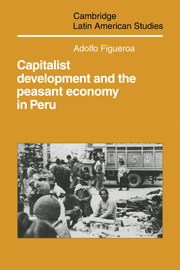Book contents
- Frontmatter
- Contents
- List of tables and figures
- Acknowledgments
- 1 Introduction
- 2 Scope and method
- 3 The economic unit and economic organization
- 4 Production and exchange
- 5 The level and structure of peasant income
- 6 The economic behavior of the peasant family
- 7 Stagnation in the peasant economy and the role of demand
- 8 Economic crisis and the peasant economy, 1975–1980
- 9 Conclusions: reality, theory and policy
- Appendixes
- Notes
- Bibliograph
- Index
- CAMBRIDGE LATIN AMERICAN STUDIES
3 - The economic unit and economic organization
Published online by Cambridge University Press: 04 August 2010
- Frontmatter
- Contents
- List of tables and figures
- Acknowledgments
- 1 Introduction
- 2 Scope and method
- 3 The economic unit and economic organization
- 4 Production and exchange
- 5 The level and structure of peasant income
- 6 The economic behavior of the peasant family
- 7 Stagnation in the peasant economy and the role of demand
- 8 Economic crisis and the peasant economy, 1975–1980
- 9 Conclusions: reality, theory and policy
- Appendixes
- Notes
- Bibliograph
- Index
- CAMBRIDGE LATIN AMERICAN STUDIES
Summary
In order to study the functioning of the peasant economy the basic economic unit of such a system must be clearly established. Who has the control of resources? Who makes the decisions on the allocation of these resources? Who makes the decisions on consumption and accumulation? This chapter is devoted to answering such questions.
Size of family and labor force
In this study, the family is defined as all those persons who habitually live in the same house. The criterion of residence poses some difficulties on account of permanent and temporary migration, and the rule adopted was to consider as resident any person who lived in the house a total of six months or more in the preceding year.
The average family size varies between 4.2 and five members in the communities (Table 3.1). The variation in these average sizes seems to bear no particular relation to the community's ecological level. Although the value of the standard deviation between family size within each community is high, the differences between communities seem to be small. These data show that it is difficult to identify a ‘typical’ peasant family size, at least without taking into account the stage of the household cycle reached by each one.
This study uses two definitions of labor force. The first, designed to take into account the role of children in production, and thus to show the family's productive capacity, includes all members of six years or more of age. The second includes persons of 18 years or more of age and measures the ‘adult labor force’.
- Type
- Chapter
- Information
- Capitalist Development and the Peasant Economy in Peru , pp. 13 - 23Publisher: Cambridge University PressPrint publication year: 1984



